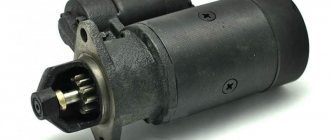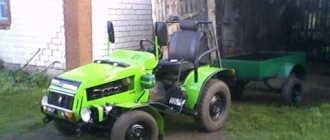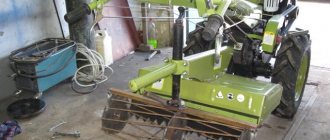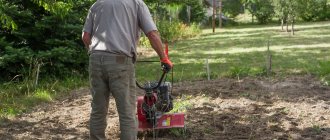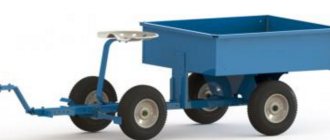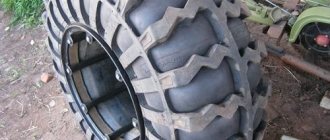Many farmers have equipment such as motor cultivators and walk-behind tractors. Both of these units help to perform any work on the ground, as well as in maintaining the territory of the site. Walk-behind tractors can also be used in winter for clearing and removing snow, breaking up icy areas and cleaning paths. However, equipment is often not used in winter and is simply put away for storage.
You can’t just pick up a walk-behind tractor in winter and leave it until spring. It is necessary to carefully prepare it for cold weather and protect parts from corrosion. In this article we will talk about how to prepare the unit for winter storage. Is it worth draining the fuel and removing the wheels? We will answer all these questions.
How to prepare equipment for spring?
In order for equipment to work without interruption in the new season, it is necessary not only to properly prepare it for the cold, but also to start it correctly for the first work.
- First of all, replace the fuel with new one. Even if you filled in fresh fuel in the fall, over the winter it could oxidize and form sediment, which could negatively affect the operation of the equipment;
- Check the spark plug. It must be securely attached and there should be no access to air;
- The fuel valve must be set to “Open” mode;
- The choke lever must be in the “Closed” position until the engine warms up;
- You need to turn the speed adjustment lever by 13 to the “Open” state;
- How to start the engine? Turn the ignition on to start the engine;
- The starter handle must be pulled until resistance appears, and then the movement must be made more abrupt. If you see smoke after the first start, do not be alarmed - it is old oil burning.
Many owners also wonder whether to remove the wheels of a walk-behind tractor for the winter? If you have metal lugs, then they need to be cleaned of dirt and dried. If the wheels are rubber, then follow the recommendations specified in the operating instructions.
General rules
Any equipment, including walk-behind tractors, is prepared for winter according to certain rules. Preservation of the unit begins with its thorough cleaning. You cannot leave the product all in the dirt and soil. After cleaning, you need to dry everything thoroughly, because moisture can ruin the parts on which rust will appear.
Inspect all parts for wear and overall serviceability. If necessary, replace with new ones. If there is water on the elements, it will simply freeze in winter and ruin the entire system. Do I need to drain gasoline and oil? With gasoline, things are very simple - you just need to drain it or fill it with new one. But with oil it will be more difficult. It needs to be replaced with a new one or the old one filtered out if it does not contain a large amount of sediment. Don't leave your equipment without oil.
All cutting parts of tools must be carefully sharpened. Check the power cord and replace it if necessary before spring arrives. With these recommendations, you are unlikely to have problems with technicians in the spring.
Why is it necessary to preserve?
Under no circumstances should you simply leave a walk-behind tractor It is necessary to preserve and store it carefully and correctly. In the worst case, after the snow melts, you simply will not be able to start the unit. Simple recommendations for storing a walk-behind tractor in winter will help you avoid mistakes in this matter.
- Pay attention first of all to the motor with gearbox. We change the oil - the previous one can also be used, but only if it is in good condition and filtered.
- We conscientiously clean the air filters and fill the engine oil.
- We unscrew the spark plugs, add oil to the cylinder (about 20 ml) and “manually” turn the crankshaft (literally a couple of revolutions).
- We carefully clean all parts of the walk-behind tractor from the accumulation of dust and dirt (do not forget about the most inaccessible places). Next, we coat the body and spare parts of the special equipment with a thick layer of oil, which will protect against corrosion. We sharpen sharp edges.
- If the walk-behind tractor is equipped with an electric starter, then remove the battery during winter storage. And also don’t forget about charging it regularly throughout the “frost period”.
- We cover the unit, or rather its painted parts, with polish. This will help protect the product from rotting. It should be noted that we apply polish only to a clean unit, otherwise it will not provide any help. With the onset of spring, the coating layer should be washed off.
- Don’t forget to open the vehicle’s fuel supply valve a couple of times a month and pull the starter handle 2-3 times.
Unit gearbox
There are two types of categories of Neva walk-behind tractors: using a classic gearbox or MultiAGRO. With the help of a gear-chain part, the following occurs:
- Increase in 1.5 times the power of the unit. This makes it possible to save time and effort during the work process.
- Increases torque to maximum at 1.8 km/h. Due to this, the walk-behind tractor is used when clearing snow and mowing the lawn.
- Ability to work at a speed of 13 km/h.
- Possibility to disable one axle shaft. This increases the maneuverability of the device and simplifies control.
If we talk about each gearbox separately, then the classic type has a standard number of gears. And this does not make it possible to adapt to the type of soil.
With the MultiAGRO gearbox, gear shifting is carried out using the handle of the unit. The number of gears will be greater than in the previous version. MultiAGRO allows you to use equipment for a long time without failures. Due to its maneuverability, it can handle complex and hard-to-reach areas.
On a note! The classic gearbox is installed on the MB-23 SD model. Despite the low power, it has high traction qualities. This is the only walk-behind tractor with a diesel engine.
How to start a walk-behind tractor in winter?
Every time before starting the engine, check the oil and fuel levels (it doesn’t matter whether winter or summer), adjust the fastenings and connections.
The procedure for starting a gasoline walk-behind tractor is as follows:
- Open the gasoline supply tap.
- Set the fuel suction lever in the “Start” mode (Choke).
- With the ignition off, the engine is run several times with the kick starter.
- Start the walk-behind tractor and switch the fuel suction lever to the “ Run ” position.
Subaru engine on a Neva MB2 walk-behind tractor in winter
Also, do not forget to prepare the fuel mixture for refueling if you have a 2-stroke engine. The process of starting a diesel engine is a little more complicated, since before starting it is necessary to bleed the air from the fuel system.
Next, the launch proceeds according to the following algorithm:
- Open the petrol tap.
- Check for presence of lubricant.
- Turn on the ignition.
- Lightly unscrew the throttle, no more than halfway.
Also, be sure to read the operating instructions before using a diesel walk-behind tractor in winter. The temperature conditions at which you need to switch from summer diesel fuel to winter diesel fuel, with a lesser degree of thickening, are clearly indicated there. Also keep an eye on the type of oil in the walk-behind tractor during the winter. For the cold season, synthetic motor oils with a lower degree of thickening at low temperatures are more suitable.
Most walk-behind tractor engines are air-cooled, which helps the engine cool down quickly in winter. Therefore, at very low temperatures, the engine will most likely have to be insulated.
Such a simple but effective method as watering the engine with warm water will also help speed up engine starting in winter. A few liters will be enough to successfully start the engine.
How to start walk-behind tractors of popular brands?
Depending on the design features and manufacturer, the launch of agricultural units can be carried out in one or another sequence. It is important to remember this, since the wrong algorithm of actions can gradually lead to serious equipment failure.
How to start a Ural walk-behind tractor?
Before starting a Ural walk-behind tractor, you need to make sure that its air filter is completely clean. You also need to inspect the spark plug - agricultural machinery of this brand is characterized by frequent leakage of engine oil from a separate tank into the engine cylinder.
Replacing the seals will help solve this problem for a short time, but they last for about 20 hours of operation.
To start walk-behind tractor , you need:
- Move the throttle control lever to the “Closed” position:
- Set the accelerator to minimum speed;
- Turn on the fuel supply valve;
- Slowly pull the starter rope until resistance appears;
- Pull the starter cable sharply towards you - as a result, the engine should start;
- Open the throttle and give the engine time to warm up.
Is it necessary to drain gasoline from a walk-behind tractor for the winter?
The operating instructions clearly state that the fuel must be drained from the walk-behind tractor before winter storage. But owners have differing opinions on this matter. Some say that it is best to drain the gasoline and let the tank dry thoroughly. Others advise filling the tank to the top to prevent corrosion.
There will be no corrosion of the tank either in the first or in the second case. But following fire safety precautions, there is no need to leave the walk-behind tractor with a full tank of gasoline. Also, gasoline may become waterlogged during inactivity.
Our advice is that before winter storage, be sure to drain the gasoline, exhaust any remaining fuel in the system, and let the tank dry. After such actions, there will be no problems with the fuel system of the walk-behind tractor in the spring.
Running in a walk-behind tractor - tips from manufacturers
The first hours of work with a new walk-behind tractor are defined as the break-in period. During this period, you should not use the engine at high speeds, and also do not use the walk-behind tractor for long and heavy work.
At the end of the break-in period, you should select the optimal engine operating mode that corresponds to the load in each case of the type of work with the walk-behind tractor. Unreasonably high engine speeds reduce its service life, which is especially evident when there is no load on the transmission.
Let's try to learn how to properly break in a new walk-behind tractor from the operating instructions and user manuals from leading manufacturers of walk-behind tractors in Russia. Here is a selection from the walk-behind tractor running-in points. All instructions can be found on our website.
Running in the MKM-3 Lander walk-behind tractor (Plowman) The first 20 hours of operation of the MKM-3 is a period of running-in of engine and transmission parts, so overloading the MKM-3 during this period is not permissible. Cultivate the soil during the running-in period to a depth of no more than 12 cm in one pass using cultivators without additional sections. Engine break-in mode: no load – 2500 rpm – 10 min no load – 3000 rpm – 10 min no load – 3600 rpm – 10 min 30% load – 3600 rpm – 10 min 60% load – 3600 rpm – 10 min
Operating equipment in cold weather
Motoblocks are widely used in the cold season. A motor cultivator with a 4-stroke gasoline (or diesel) engine can handle snow removal.
READ Tools for working with polymer clay
The universal unit is capable of performing the following functions in winter:
- acts as an additional source of electricity (power adapter);
- indispensable for procurement work (garbage removal, firewood collection);
- removes snow from the territory;
- a vehicle for fishing in winter, and the trailer will serve as a storage place for fishing rods, a tent and a sleeping bag.
We work on MOTOBLOCK in winter! What do you need to know?
Many people wonder whether it is necessary to heat the oil in order to take the unit on winter fishing. The process of heating the engine is necessary when turning on the walk-behind tractor in the cold. So, let's look at the features of turning on the unit in winter.
- Modern walk-behind tractors require cooling (air). This simplifies their operation at sub-zero temperatures. However, the disadvantage is that the engine cools quickly in winter.
- There are special insulation covers for walk-behind tractors. This will help maintain the “right” temperature.
- In winter, the engine must be preheated (by diligently pouring hot water).
- Gearbox oil tends to thicken at low temperatures. Therefore, it is best to use its synthetic types or a rather liquid structure.
Snow removal equipment
Almost all walk-behind tractors are adapted to work with all types of snow removal equipment. In rural areas, dealing with snowdrifts is a daily task.
A motor cultivator with a bracket and a power take-off shaft can be used to work with the following equipment:
- Rotary snow blower. This is a very effective device that grabs snow with spiral knives and throws it at a distance of up to 5 m. The capture ranges from 60-120 cm.
- Front blade. You should purchase a device that can be adjusted horizontally and vertically. The bottom rubber strip ensures smooth movement and protects the blade from damage. The width of the knife can reach 130 cm.
- Rotary brush. Used to remove dry and soft snow from uneven surfaces and paved paths. Captures snow to a width of 70-100 cm.
When preparing for winter, you should purchase ground hooks to ensure the forward movement of the device on compacted snow and ice.
Preparing the walk-behind tractor for winter
Before sending the walk-behind tractor for winter storage, you need to carry out a number of procedures for its successful “wintering” and high-quality work in the spring. First of all, before the onset of frost, the walk-behind tractor should be washed and dried thoroughly, and minor damage should be eliminated. Thoroughly lubricate all working mechanisms and components. Also clean, sharpen and lubricate the cutting elements of the attachments.
The walk-behind tractor stored in a dry, ventilated area. There is no need for additional heating.
Basic rules for preserving a walk-behind tractor for the winter:
We also invite you to watch the video, which shows the process of preparing a walk-behind tractor for winter:
General rules for equipment conservation
Before leaving your equipment for the winter, you need to thoroughly wash it, dry every part, and inspect it for breakages and damage.
The worst thing for any car is moisture left on the parts. Water freezes in winter and damages elements. For safety reasons, the fuel needs to be drained (however, some owners have a different opinion). But with oil there are other tips - you should not leave equipment without lubrication in the winter. However, it needs to be replaced with a new one.
All cutting objects must be thoroughly cleaned and sharpened. The hinge joints also require careful cleaning and lubrication. Also, do not forget to check the power cord - if it is damaged, replace it with a new one before the onset of cold weather and, especially, spring.
How to winterize your trimmer
The next important tool for every summer resident is a gas trimmer. Its proper storage is one of the main factors of long service to the owner.
- The wintering place should be warm, with low humidity, insulated from temperature changes. The gas trimmer should not freeze; it should be wrapped in an unnecessary blanket or other desiccant.
- All fuel from the tank must be removed and the trimmer should be run idle, waiting until it stalls.
- Inspect the spark plug for carbon deposits. To do this, you need to unscrew it and take it out. If the electrodes are red or close to it, everything is in order, a different color indicates that they need to be cleaned or replaced.
- The knife must be stored separately. Remove it, clean it from dirt, check for cracks or chips.
- If you have a trimmer cord, you can extend its service life by storing it in water. Thanks to this, the fishing line will retain its elasticity.
- For wintering, the trimmer should be suspended.
Where to store: options and necessary conditions
- Shed or outbuilding
Almost every summer resident has a barn or an equipped utility block on the property. These storage locations are the most common. The main conditions for storing gasoline equipment in sheds or utility rooms are low humidity and stable temperature without sudden changes. If the room is insulated, this will be an additional advantage.
- Garage
Another place to store gasoline equipment is the garage.
You should not place the equipment close to the car, and when hanging it, you need to make sure that if it falls, it will not hit the car. Where do you store gasoline equipment in winter?
GarageBarn
- Special storage
This method is not very popular in Russia and post-Soviet countries. But if there are no other options, it is possible to find a company that provides these services.
What you should pay attention to:
- How long has the company been on the market, customer reviews.
- What premises and storage conditions does the company provide?
How to prepare a walk-behind tractor for winter?
Motoblocks are quite complex and expensive equipment. If you decide to make such a purchase, then you must be prepared to carefully care for it. This applies not only to timely repairs, the purchase of high-quality oil and fuel, but also to preparing the walk-behind tractor for winter.
There are cases when owners of such equipment do not bother about storing the walk-behind tractor in winter. As a result, they encountered a lot of problems - from damaged wires to the fact that the equipment simply would not start.
To prepare the walk-behind tractor for winter storage, it is necessary to carry out a number of actions. There are general storage rules, but there are also specifics for each type of gardening equipment.
Winter Attachment Options
Rotary snow removal attachments are a design based on an auger placed in a metal closed housing. As the auger rotates, snow flows to the impeller and then to the pipe nozzle. The ejection of mass occurs directionally, over a distance of several meters. The path remains clear.
Standard snow attachments are made in the form of a flat metal knife - a smaller version of a bulldozer blade. The cutting edge of the tool is covered with a rubber pad so as not to damage paving slabs, paving stones, and other delicate coatings.
Municipal brushes effectively cope with freshly fallen, loose snow and allow you to clean the surface to an almost ideal state. Soft bristles are safe for coatings.
Depending on weather conditions, pneumatic wheels, lugs or tracks can be installed on the walk-behind tractor. Maximum cross-country ability on snow will be ensured by caterpillar tracks. Pneumatic wheels are convenient for driving on hard surfaces. And the lugs will help break up the thick ice crust.
How to prepare equipment for spring?
In order for equipment to work without interruption in the new season, it is necessary not only to properly prepare it for the cold, but also to start it correctly for the first work.
We start the Patriot walk-behind tractor at MINUS.25!
- First of all, replace the fuel with new one. Even if you filled in fresh fuel in the fall, over the winter it could oxidize and form sediment, which could negatively affect the operation of the equipment;
- Check the spark plug. It must be securely attached and there should be no access to air;
- The fuel valve must be set to “Open” mode;
- The choke lever must be in the “Closed” position until the engine warms up;
- You need to turn the speed adjustment lever by 13 to the “Open” state;
- How to start the engine? Turn the ignition on to start the engine;
- The starter handle must be pulled until resistance appears, and then the movement must be made more abrupt. If you see smoke after the first start, do not be alarmed - it is old oil burning.
Many owners also wonder whether to remove the wheels of a walk-behind tractor for the winter? If you have metal lugs, then they need to be cleaned of dirt and dried. If the wheels are rubber, then follow the recommendations specified in the operating instructions.
Why won't the walk-behind tractor start?
Owners of agricultural machinery often encounter various malfunctions. For example, the walk-behind tractor does not start and shoots. To eliminate a breakdown, you first need to determine its cause.
After that, they directly repair the equipment themselves or contact a service center. In this article we will talk about why the walk-behind tractor does not start and how to fix it.
Causes and solutions
The walk-behind tractor does not work - reasons:
- insufficient amount of engine oil;
- malfunctions in the performance of filament and ignition devices;
- malfunctions in the internal combustion engine power supply system of a mini-tractor with a gasoline engine.
Often the reasons that a walk-behind tractor does not start are due to improper operation of the spark plugs or glow plugs. This is due to the fact that the parts lost spark due to excessive humidity. It occurs as a result of throwing the fuel assembly.
If there is no sparking, then the walk-behind tractor engine will not start. How to solve the problem:
- repair or replace the damaged part with a new one;
- “burn through” the flooded spark plugs, thus clearing them of any remaining fuel.
If the diesel walk-behind tractor does not start, and the glow plugs are still functioning properly, then check the operation of all devices that are responsible for the flammability of the combustible substance.
Operating equipment in cold weather
Motoblocks are widely used in the cold season. A motor cultivator with a 4-stroke gasoline (or diesel) engine can handle snow removal.
The universal unit is capable of performing the following functions in winter:
- acts as an additional source of electricity (power adapter);
- indispensable for procurement work (garbage removal, firewood collection);
- removes snow from the territory;
- a vehicle for fishing in winter, and the trailer will serve as a storage place for fishing rods, a tent and a sleeping bag.
Many people wonder whether it is necessary to heat the oil in order to take the unit on winter fishing. The process of heating the engine is necessary when turning on the walk-behind tractor in the cold. So, let's look at the features of turning on the unit in winter.
- Modern walk-behind tractors require cooling (air). This simplifies their operation at sub-zero temperatures. However, the disadvantage is that the engine cools quickly in winter.
- There are special insulation covers for walk-behind tractors. This will help maintain the “right” temperature.
- In winter, the engine must be preheated (by diligently pouring hot water).
- Gearbox oil tends to thicken at low temperatures. Therefore, it is best to use its synthetic types or a rather liquid structure.
Winter functions of the walk-behind tractor
Cargo transportation . In winter, with the help of a walk-behind tractor and a trailer, it is convenient to transport tools and things, firewood for heating the house, building materials, and take out garbage. Fans of winter fishing also use units for transporting fishing rods and tents to the reservoir and back.
Cleaning the area . The equipment is combined with snow blowers, dumps, and various brushes for clearing the area. A walk-behind tractor is a convenient solution for maintaining sidewalks, narrow paths, local areas, garden plots, and car parks in the winter.
How to prepare a walk-behind tractor for winter?
As mentioned above, walk-behind tractors are serious equipment that requires the same attitude. If you do not want to encounter breakdowns, and even more so the need to purchase new equipment, then store the walk-behind tractor in winter.
The entire conservation process proceeds as follows:
- First of all, take care of the engine and gearbox. They definitely need to change the oil. You can also use the old one, filtering it well, but provided that it is still in good condition. When spring comes, you will still have to change the oil again, since it will deteriorate when left standing;
- The fuel tank may be subject to corrosion. And here opinions differ: some advise drying it by draining the gasoline, and some recommend pouring fuel to the very top so that corrosion has no chance. In both cases there will be no corrosion, but with fuel the risk of fire increases;
- Clean the air filters thoroughly and fill with engine oil if they are in an oil bath;
- Some experts advise unscrewing the spark plugs, pouring about 20 milliliters of oil into the cylinder, and also turning the crankshaft several revolutions;
- After the previous four points, you can start cleaning the rest of the walk-behind tractor from dirt and dust. The same applies to attachments, which also need to be lubricated with oil and sharp edges sharpened;
- If you are the owner of a walk-behind tractor with an electric starter, then you should store the battery for it in a warm room. You will also need to fully charge it several times during the winter months;
- If desired, you can also cover the walk-behind tractor , or rather its painted parts, with a protective layer of a special polish that will protect the product from rotting. It is important to apply it to a clean surface, because under a layer of dirt the equipment will still deteriorate. When spring comes, the polish needs to be washed off.
READ Motoblock Neva Which Engine Is Better
If you follow these simple recommendations, then in the new season you will not have any problems either starting the walk-behind tractor or with its operation.
Malfunctions and their elimination in the Mole motor-cultivator
Every piece of equipment that is used to perform a large volume of work breaks down over time. There can be many reasons for this, for example:
- The working life of the part is nearing its end.
- Defective components installed on equipment during the assembly process.
- Incorrect operation.
- Late and superficial maintenance.
- Excessive loads on the walk-behind tractor, as a result of which parts fail faster.
- Error in assembly at the factory.
All these reasons lead to the fact that technology can:
- Wedge.
- Refuse to start.
- No spark when turned on.
- Gearbox failure.
- Failure of the walk-behind tractor belt.
In this video we will look at how to repair a motor cultivator:
All these malfunctions make further operation of the equipment impossible, and not everyone knows how to fix them. Let's look at each problem situation in more detail and decide on the algorithm of actions if it arises.
Does not start
If the walk-behind tractor refuses to start, do the following:
- Check the condition of the drain hole located in the fuel tank. If it is clogged, the motor will not work.
- Inspect the air filter. If it becomes clogged and fails, replace it with a new one.
- The spark plug may be faulty, preventing the engine from starting. There are many reasons for the problem, and we will consider them separately.
- If a flame bursts out of the muffler while working on equipment, this is bad. This may cause the flywheel key to become deformed and you will have to replace it.
- Check the condition of the cylinder seals.
- Make sure the gasket between the filter and the carburetor is in good condition. During the assembly process, it may have been installed incorrectly, or it may have worn out.
- Stopper sludge clogged. This happens after winter, when the walk-behind tractor sits idle in the garage. During this time, various debris accumulates around the needle, which interferes with further operation of the system.
- Make sure that the fuel used to start the walk-behind tractor meets the manufacturer's requirements and is of high quality. If this is not the case, the equipment will work intermittently, and in the future it will not start at all.
- The magneto, which acts as an ignition coil on the walk-behind tractor, has failed. In this case, replace the faulty part with a new one.
Owners of walk-behind tractors who are not confident in their abilities should contact specialists who will carry out diagnostics and identify all faults. Trying to do it yourself for the first time can only make things worse.
Note! After each use of the walk-behind tractor, and first of all upon completion of all seasonal work, do not forget to carry out maintenance of the equipment. This will significantly increase the working life of the walk-behind tractor and reduce the number of breakdowns in the future.
No spark
Engine failure can occur due to a faulty spark plug. Reasons why there is no spark in the engine:
Carbon deposits formed around the spark plug during operation. Eliminate the malfunction by dismantling the spark plug and cleaning the dirt from it. There is a spark, but the engine does not start. This is possible when the tip of the spark plug is wet due to fuel or oil getting on it. The solution to the problem is to replace the tip. Periodically, fuel floods the engine cylinder, causing the spark plug to become wet and prevent the spark from passing through. In this case, remove excess fuel and dry the spark plug by manually pumping the walk-behind tractor engine with the starter. The spark plug has failed
Replace the damaged part. When dismantling the spark plug, pay attention to the O-ring. It plays an important role in the system.
Wedge
The engine of agricultural machinery that is actively used can seize and fail. Reasons for this behavior:
- Not enough oil enters the crankcase, as a result of which the engine refuses to work.
- The connecting rod has failed and requires replacement.
- A scoring mark forms on the connecting rod head, in its lower part. A similar malfunction occurs if there is insufficient lubrication during startup, an error occurred when installing a part, or the piston pin is seated too tightly.
At the first sign of engine seizure, disassemble it and check the main parts and components for integrity. Deformed, damaged or failed components must be replaced immediately. Otherwise, the motor will completely fail and cannot be restored.
Preparation of units with four-stroke engines
In this case, special attention should be paid to the gas tank.
Ways to prepare this equipment for winter:
- Fill the gas tank with fuel with the addition of a special additive. This is done to ensure that the fuel does not separate during storage. Using this method, you can be sure that during cold storage no condensation will form inside the gas tank.
- Empty the tank. Having settled on this method, it is necessary to treat the internal surfaces of the gas tank, intake manifold and cylinders with agents that prevent oxidation. Before wintering, the oil from the collector should be drained to avoid the formation of sediment and loss of its properties.
- Safety of hoses and wires
Over the winter, wires and hoses can oxidize or lose their elasticity. To avoid this, it is recommended to use aerosols containing wax and silicone. Their convenience is that after wintering there is no need to remove the coating from the surfaces before putting the equipment into operation.
To ensure the safety of wheels and tires during long-term storage, it is recommended to remove them from the equipment or install the equipment on special stands. Additionally, do not forget about the storage temperature specified by the rubber manufacturer.
- Temperature and humidity
Rubber seals, oil seals and rings are most susceptible to temperature fluctuations and changes in humidity. The main danger is moisture, which in the form of condensation penetrates into the moving parts of equipment, freezes in them, and, expanding, causes mechanical damage.
Petrol lawn mower
The main parts of a lawn mower are the blades and the engine.
They must be prepared for winter with special care:
- The first and most important point to pay attention to is the humidity in the storage room. It should be low. The second condition is to avoid temperature changes that increase humidity.
- If the scythe has been used frequently during the season, much attention should be paid to the cutting mechanisms. They need to be cleaned of grass residues and related particles. In the same way, you should clean all parts within reach.
- Owners deal with fuel differently. One half prefers to fill the lawnmower tank completely, and this option has its place. However, you need to be prepared for the fact that gasoline may precipitate over the winter, and in the spring you will have to clean the carburetor. The second option is considered more acceptable: all fuel is drained from the tank, the tank is wiped dry to avoid the formation of condensation.
- The knife must be carefully inspected and, if necessary, repaired or replaced. If not required, simply remove it and sharpen it.
- The amount of oil must be checked with the operating instructions.
- The lawn mower should be stored without contact with the floor (it can be hung or placed on a special stand).
How to start a walk-behind tractor in winter - tips for beginners
The advantages of a modern walk-behind tractor are its versatility and high performance. Provided that the appropriate attachments are available, the unit available on the farm can be actively used in winter - for clearing large amounts of snow and solving other household tasks.
At the same time, improper operation of the walk-behind tractor in winter, and especially its incorrect starting, significantly reduces the working life of the main mechanisms of the unit. What to do. to avoid typical mistakes when starting a “cold” walk-behind tractor?
First of all, you will need to understand the type of cooling system provided in its design. Units equipped with an air system are easier to store and start up in winter - they do not require quickly freezing antifreeze and constant checking of the radiator. At the same time, the air cooling system also has its drawback - the engine with it heats up faster, which means it cools down faster, which will not allow you to take long breaks when working in winter.
Many walk-behind tractors require preliminary insulation of their engines to operate in winter. For this purpose, both branded covers and various improvised means can be used - blankets, rugs and other fabric products. It is especially important to ensure high-quality insulation in severe frost conditions, down to 20 ⁰C. If the temperature does not drop below 5–10 ⁰C, then this step can be skipped.
The place in which the walk-behind tractor . If the unit is planned to be actively used in winter, then it is best to choose a heated room for this - a garage or other domestic building.
When using a walk-behind tractor intensively in winter, it is extremely important to take care of the oil poured into the gearbox. Synthetic oils are better for use in winter, since at sub-zero temperatures they retain their most important properties longer than mineral oils. In any case, it is best to use thinner oils that do not thicken so quickly in the cold.
By following all these rules, the owner of the walk-behind tractor will be able to easily start his unit. Starting an agricultural machine in winter is carried out in the same sequence as at any other time of the year. The only difference is to let the walk-behind tractor idle for at least 15 minutes - during this time its engine will warm up and be completely ready for work. More details about starting a walk-behind tractor in winter can be found in the video.
Motoblock "MTZ" 06
A mid-power walk-behind tractor designed to perform a range of field and utility work. It has a uniaxial design typical for MTZ walk-behind tractors, which is driven by a 4-stroke SK-6 gasoline engine with a 245 cm³ cylinder capacity. With gasoline consumption similar to the 5th version, it generates a power of 5.5 hp
Compact, which is important for storage and transportation. Due to the embossed tread of pneumatic tires, the walk-behind tractor overcomes off-road and swampy areas without slipping and does not require the installation of lugs.
Advantages:
- reliability of material and technical equipment, making the unit practically “indestructible”;
- 6 operating modes, including 2 for reverse;
- friction clutch, which is controlled manually;
- a special hitch that makes it easier to hang auxiliary devices;
- reasonable price.
Operating parameters:
- Passage width – 0.45/0.6/0.7 m;
- Load capacity – 650 kg;
- Wheels – 15 x 33 cm;
- Dimensions – 1.8/0.85/1.07 m;
- Weight – 135 kg.
Serious equipment: storage of cultivators and walk-behind tractors
A large number of parts and incomplete accessibility of all parts of this equipment do not always allow for full preparation for winter storage, but several stages of preparation must be done:
- First of all, you need to prepare the engine. After the fuel has been drained and the remainder has been used up, you need to change the oil while the engine is still warm.
- We clean the filters: we update the paper ones, wash the foam ones, dry them and soak them in machine oil. Clean the fuel filter.
- The spark plug needs to be cleaned and dipped in gasoline. While it dries, pour oil into the cylinder and distribute it by turning the shaft. Then we wrap the candle back.
- We thoroughly clean the engine and muffler of dirt. The gearbox should not be cleaned using metal scrapers; the protection can be damaged and consequences may occur in the form of rust. It is better to use wooden devices, washing all the elements. After parts come into contact with water, they must be dried;
Preparing a walk-behind tractor for winter
Proper preparation of the equipment before the winter period plays a huge role in extending the service life of the walk-behind tractor available on the farm. Many novice farmers make big mistakes by leaving the unit to overwinter in unsuitable conditions, or trying to start it in sub-zero temperatures without prior preparation. As a result, the main mechanisms of the equipment are subject to increased wear and tear, and inevitably fail at the most inopportune moment.
READ Assembling 18650 batteries for a screwdriver
Motoblock starter design - design features of the mechanism
Each walk-behind tractor model has its own design features and is equipped with different mechanisms. Thus, to equip more modern agricultural units, manufacturers use two starters at once.
A spring or auxiliary starter helps the main starter start quickly and smoothly. The main mechanism is a manual starter, which is responsible for starting the motor of the walk-behind tractor. Among the main elements of the walk-behind tractor starter are:
- Coil;
- Drum body;
- Washer, large and small spring;
- Reeds;
- Cord;
- Mounting nuts and bolts.
The reel on which the cord is wound is attached to the core of the drum body. A large spring is installed in the inner chamber of the drum, which is responsible for returning the drum to its previous position after each pull of the cord.
Some walk-behind tractors are equipped with an electric starter. The electric starter for the walk-behind tractor takes power from the battery. The larger the capacity of the latter, the longer the motor starting mechanism will work.
Both the manual kickstarter and the electric starter for the walk-behind tractor have proven to be quite reliable mechanisms with long service life and resistance to mechanical damage.
How to start a walk-behind tractor in winter - tips for beginners
The advantages of a modern walk-behind tractor are its versatility and high performance. Provided that the appropriate attachments are available, the unit available on the farm can be actively used in winter - for clearing large amounts of snow and solving other household tasks.
At the same time, improper operation of the walk-behind tractor in winter, and especially its incorrect starting, significantly reduces the working life of the main mechanisms of the unit. What to do. to avoid typical mistakes when starting a “cold” walk-behind tractor?
First of all, you will need to understand the type of cooling system provided in its design. Units equipped with an air system are easier to store and start up in winter - they do not require quickly freezing antifreeze and constant checking of the radiator. At the same time, the air cooling system also has its drawback - the engine with it heats up faster, which means it cools down faster, which will not allow you to take long breaks when working in winter.
Many walk-behind tractors require preliminary insulation of their engines to operate in winter. For this purpose, both branded covers and various improvised means can be used - blankets, rugs and other fabric products. It is especially important to ensure high-quality insulation in severe frost conditions, down to 20 ⁰C. If the temperature does not drop below 5–10 ⁰C, then this step can be skipped.
The place in which the walk-behind tractor . If the unit is planned to be actively used in winter, then it is best to choose a heated room for this - a garage or other domestic building.
When using a walk-behind tractor intensively in winter, it is extremely important to take care of the oil poured into the gearbox. Synthetic oils are better for use in winter, since at sub-zero temperatures they retain their most important properties longer than mineral oils. In any case, it is best to use thinner oils that do not thicken so quickly in the cold.
By following all these rules, the owner of the walk-behind tractor will be able to easily start his unit. Starting an agricultural machine in winter is carried out in the same sequence as at any other time of the year. The only difference is to let the walk-behind tractor idle for at least 15 minutes - during this time its engine will warm up and be completely ready for work. More details about starting a walk-behind tractor in winter can be found in the video.
User manual
The MTZ-09N walk-behind tractor is easy to use, however, in order to extend its service life, it is necessary to properly monitor its condition.
- Before each trip, visually inspect it for any defects. It is recommended to check the security of all bolted connections.
- There are often reviews regarding the rapid appearance of rust. After each work, the remaining soil or snow should be removed in order to prevent corrosion from occurring in Belarus.
- The design of the MTZ-09N gas tank provides for fuel intake at a height of 2 cm. This decision by the engineers was made in order to prevent dirt and dust from getting into the fuel system from the bottom of the gas tank. Many owners of MTZ-09N do not know this and write reviews not understanding why there is fuel, but the walk-behind tractor does not start.
- Based on reviews, people often do not pay attention to the oil level. If there is insufficient lubrication of the walk-behind tractor elements, there will be a sharp sound and rapid wear of the parts. This cannot be allowed.
- It is recommended to fill the engine crankcase with 10W-30 series oil. This is a universal all-season lubricant that can ensure reliable operation of Belarus at any time of the year. The volume of the crankcase of the MTZ-09N walk-behind tractor is 0.6 dm3. In order to change the oil in the crankcase, you should completely drain the oil that is there, fill in the flush and let it idle. This is done so that waste residues are removed from the engine. And then new clean oil is poured in.
- During hot periods of the year, it is recommended to fill the transmission with M-10V2 or M-10G2. If you have an M-6z/10V at hand, then it can be used as an alternative.
- In winter, it is recommended to fill in the less viscous M-8G2. As an alternative, you can use M-4z/10V.
- To change the oil, you need to warm up the transmission, then place a basin and drain the oil completely. Then fill the level with a new one and run it through the system at idle speed.
- Regardless of the time of year, it is necessary to fill in 3.6 liters of oil.
Important TOP 3 Chinese mini balers for collecting hay
You can download the factory operating instructions for the MTZ-09N walk-behind tractor using this link Operating instructions for the Belarus MTZ-09N walk-behind tractor
Preparing a walk-behind tractor for winter - what should you take care of?
Proper preservation of a walk-behind tractor for the winter is an important topic that allows, if not extending, then at least preserving the working life of the unit used on the farm. The preparation of an agricultural machine itself is not a complicated procedure. It is enough to study a number of rules and tips that will help you maintain your walk-behind tractor and start it without problems after wintering.
When sending the unit for winter storage, you will need:
- Completely replace the oils in the engine and gearbox of the unit. To do this, you will need to fill the appropriate tanks with a new lubricant for the winter, or, in extreme cases, filter out the old one, making sure that there is no sediment in it. In any case, with the onset of spring, the oil will need to be replaced;
- Wash all the filters in the walk-behind tractor. If the unit is equipped with filters placed in an oil bath, then they will need to be filled with fresh engine oil;
- Many experienced farmers recommend unscrewing the spark plugs of the walk-behind tractor before winter storage, then pouring no more than 20 ml of engine oil into the working cylinder, and manually turning the crankshaft of the unit, performing just a few revolutions;
- the walk-behind tractor must be washed from dirt, not missing parts located in hard-to-reach places. After washing, you will need to apply a thick layer of oil to the body and spare parts of the unit, which will help prevent the formation of corrosion;
- if possible, instead of oil, a special polish with a protective function can be applied to the parts of the walk-behind tractor - it forms a durable film on the metal surface that will prevent the metal from rotting in winter. In this case, it is very important to apply the product to a clean surface, since otherwise it will not protect the metal parts of the walk-behind tractor;
- All spark plug caps and electrical connectors of the unit should be lubricated with silicone grease in the form of a spray for the winter - it will effectively protect them from exposure to various environmental factors;
- If the walk-behind tractor is designed with an electric starter, then while storing it in winter it is best to remove the battery from the unit and move it to a dry and warm room. The battery will need to be fully charged several times during storage;
- In order to prevent the rings from sticking into the cylinders in winter, you will need to open the fuel supply valve of the walk-behind tractor several times a month and pull the starter handle 3-4 times.
By adhering to these simple rules, the farmer will provide optimal conditions for storing the walk-behind tractor in winter. With the onset of spring, the unit can be taken out of the room, the oil can be changed, and operation of the unit can begin.
Snowmobile from a walk-behind tractor
Buying a snowmobile requires a serious financial investment. This equipment consumes a lot of fuel and requires special storage conditions. It is much easier and cheaper to convert a walk-behind tractor into an all-terrain vehicle. Driving such a vehicle is possible both on snow and on muddy mud in the summer.
No special training is required to perform this work. It is quite possible to limit yourself to those tools and materials that are available in every home workshop.
When planning to convert a walk-behind tractor into a snowmobile, it is necessary to take into account a number of nuances:
- Starting a walk-behind tractor at subzero temperatures can be problematic. It is especially difficult to start a diesel engine. It should be possible to install an electric starter and battery. This device will allow you to start the engine quickly without any effort.
- To drive on public roads, homemade equipment must be equipped with a headlight and side lights. To equip a lighting system, you will need to install a generator or battery. To save energy on a walk-behind tractor in winter, it is better to use modern LED lamps.
- Since a homemade snowmobile does not have a sufficient safety margin, you should not accelerate on it faster than 30 km/h. It is necessary to provide a ramp design so that every time you do not have to think about how to get the unit into the garage.
When planning the design of a homemade snowmobile, you should make the right choice regarding what speed it will be on. The wheels provide good speed and maneuverability. Setting up a wheeled chassis is quite simple. In order to get an all-wheel drive vehicle, it is necessary to weld sprockets to the axles and connect them with a chain. The excellent maneuverability of such devices speaks in favor of the caterpillar drive. As for handling, you can improve it by installing 1 or 2 skis instead of the front stop.
The snowmobile frame must be made of reinforced steel angle. In this case, you need to monitor the weight of the trailer so that it does not outweigh the body of the tractor. Otherwise, you may encounter the problem of poor adhesion to the ground or snow.
To make tracks, you can take a conveyor belt or old tracks from Buran. If you have the funds, it is better to buy ready-made modular chassis. Wheels should be chosen with a large diameter and width. The tread should be as deep as possible.
Is it necessary to drain gasoline from a walk-behind tractor for the winter?
There is a lot of controversy about whether it is necessary to drain gasoline during the winter storage of a walk-behind tractor. Some farmers advise storing the unit without fuel, others have a completely opposite opinion.
In fact, it all depends on the type of fuel consumed. If the farm uses a diesel walk-behind tractor , then not everyone can store it in very severe frosts with fuel in the tank. This is primarily due to the property of diesel to freeze already at 10 ⁰C. To avoid this, various additives can be poured into the diesel fuel tank to prevent the fuel from freezing. At the same time, even the most effective additives are not able to maintain the liquid state of diesel at temperatures of .25 ⁰C and below. Therefore, if the winter in the region is very cold, then before storage it is best to drain all the fuel from the diesel walk-behind tractor.
The situation is completely different with gasoline walk-behind tractors. Most experts are inclined to believe that such units are best stored with a full tank of fuel. This will help prevent corrosion from forming on the inner surface of the fuel tank walls. It is extremely important to fill the tank completely, otherwise rust may form on the walls in the empty part of the tank.
Sources:
https://ros-tile.ru/motobloki/kak-podgotovit-motoblok-k-zime https://pro-traktor.ru/motobloki/podgotovka-k-zime.html
Popular questions from equipment owners
Do I need to drain gasoline for the winter?
There are two opinions. Some equipment users claim that storing a walk-behind tractor in winter is only possible with an empty tank, while others claim that gasoline in the tank is necessary. It all depends on the type of fuel.
Diesel freezes already at -10°C. In cold winters, the fuel tank may simply burst. You can increase the frost resistance of a diesel engine using additives, but they only work down to -25°C. To preserve the system, it is better to drain the fuel.
Gasoline is more frost-resistant. Moreover, it protects the walls of the fuel tank from corrosion due to the presence of special additives. If you plan to leave the unit in storage with gasoline, then you need to fill the entire container up to the neck.
In which room is it better to store the walk-behind tractor?
The equipment is placed under a roof, in a dry and ventilated room. If the unit is mothballed, there is no need to heat it. If the walk-behind tractor is stored in an unheated room (in the cold), the fuel is drained and the engine is turned on to completely empty the fuel system.

